Year Round Whale Watching Cruises
Choose from multiple times a day every day year round. Each cruise is approximately 2½ hours in length and can travel up to 15 miles from Newport Bay in search of many species of whales and dolphin. Newport Beach has become a world renowned whale watching destination with whales viewed year round and in such great numbers that it is rare for a whale watching cruise to not view whales. It is hard to believe that such a thriving marine environment is so close to one of the largest metropolitan areas in the world. Factor in great weather year round and calm ocean conditions and this is a perfect cruise for all ages to enjoy these amazing creatures.
CRUISES DAILY - YEAR ROUND
| Adult | Juniors | Seniors | |
|---|---|---|---|
| Weekday | $38.00 | $34.00 | $34.00 |
| Weekends | $42.00 | $38.00 | $38.00 |
Whales to watch out for on the West Coast
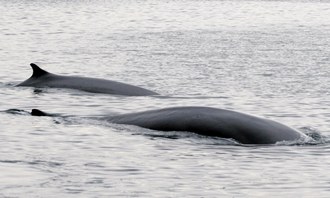 FIN WHALE (Apr to Nov) -
Fin whales are very slender and sleek and are the second largest whale next to the blue whale and may be almost equivalent to the blue whale in size in the northern hemisphere. Fin whales are also rorqual whales with dorsal fins and pleated throat grooves. They have a very unique coloration with brownish/black on top and on its sides and two lighter colored chevron patterns behind the blow holes. The underside of the body, fins and fluke are white. However the most unique part of their coloration is the dark grey and white coloration is split down the side of their head with grey on the left side and white on the right side and extends to the baleen coloration as well. The colors on the tongue however are reversed. This split coloration is thought to aid in feeding.
FIN WHALE (Apr to Nov) -
Fin whales are very slender and sleek and are the second largest whale next to the blue whale and may be almost equivalent to the blue whale in size in the northern hemisphere. Fin whales are also rorqual whales with dorsal fins and pleated throat grooves. They have a very unique coloration with brownish/black on top and on its sides and two lighter colored chevron patterns behind the blow holes. The underside of the body, fins and fluke are white. However the most unique part of their coloration is the dark grey and white coloration is split down the side of their head with grey on the left side and white on the right side and extends to the baleen coloration as well. The colors on the tongue however are reversed. This split coloration is thought to aid in feeding.
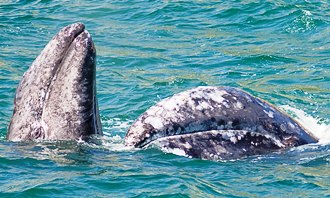 GRAY WHALE (Dec to May) -
Gray whales are medium sized whales, reaching up to 45 feet (14 m) in length, with the females usually being larger than the males. They are gray with white patches, which mostly consist of areas where barnacles and lice have attached themselves to the whales. In fact, they carry over 400 pounds of barnacles and whale lice. Gray whales have no dorsal (back) fins. Instead, they have a low hump and a series of six to twelve knuckles or bumps. Gray whales are baleen whales, and each has approximately 300 plates of cream-colored baleen hanging from its upper jaw. Two to five throat creases allow their throats to expand during feeding. Sparse hairs are found on the snout, especially in young whales. Their blows are usually low and puffy or heart-shaped.
GRAY WHALE (Dec to May) -
Gray whales are medium sized whales, reaching up to 45 feet (14 m) in length, with the females usually being larger than the males. They are gray with white patches, which mostly consist of areas where barnacles and lice have attached themselves to the whales. In fact, they carry over 400 pounds of barnacles and whale lice. Gray whales have no dorsal (back) fins. Instead, they have a low hump and a series of six to twelve knuckles or bumps. Gray whales are baleen whales, and each has approximately 300 plates of cream-colored baleen hanging from its upper jaw. Two to five throat creases allow their throats to expand during feeding. Sparse hairs are found on the snout, especially in young whales. Their blows are usually low and puffy or heart-shaped.
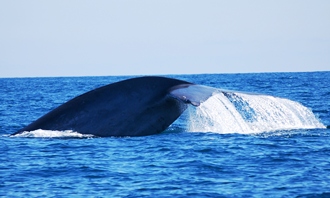 BLUE WHALE (May to Oct) -
These whales are the largest animal on the planet. They can reach lengths of over 100 feet although typically they range from 75-80 feet in the Northern Hemisphere. Females are generally larger than males due to the need for extra weight for birthing and caring for the calf. Given the name Blue whale, these whales have an aqua blue hue that seems to glow beneath the waters surface. These whales are fast travelers and have a smooth appearance with no barnacles or parasites unlike other slower whale species such as gray whales or humpbacks. Blue whales have a very small dorsal fin located about ¾ of the way back on their body and 60-90 throat grooves. A blue whale spout or blow can be seen for miles as it reaches nearly 20 feet into the air like a giant geyser.
BLUE WHALE (May to Oct) -
These whales are the largest animal on the planet. They can reach lengths of over 100 feet although typically they range from 75-80 feet in the Northern Hemisphere. Females are generally larger than males due to the need for extra weight for birthing and caring for the calf. Given the name Blue whale, these whales have an aqua blue hue that seems to glow beneath the waters surface. These whales are fast travelers and have a smooth appearance with no barnacles or parasites unlike other slower whale species such as gray whales or humpbacks. Blue whales have a very small dorsal fin located about ¾ of the way back on their body and 60-90 throat grooves. A blue whale spout or blow can be seen for miles as it reaches nearly 20 feet into the air like a giant geyser.
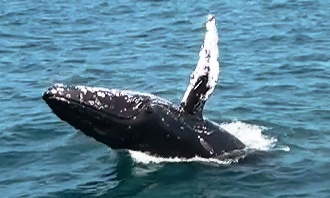 HUMPBACK WHALE (Feb - Apr | Sept - Oct) -
The humpback whale has two blowholes, fins on their backs and ventral pleats that go from their lower jaw to their stomachs. They are a larger whale ranging in size from 40-50 feet and weighing 25-40 tons. The four-chambered heart of the average humpback whale weighs about 430 pounds. The females are slightly larger due to the need to give birth and care for their young. The head, fins, and fluke of a humpback whale have a bumpy texture to them and may be covered with barnacles. Their bodies are rounded and are black on the upper (dorsal) side and mottled black and white on the under (ventral) side. The coloring and shape of a humpback whale's dorsal fin and fluke are completely unique to each whale. The flippers are between 1/4 and 1/3 of it body length.
HUMPBACK WHALE (Feb - Apr | Sept - Oct) -
The humpback whale has two blowholes, fins on their backs and ventral pleats that go from their lower jaw to their stomachs. They are a larger whale ranging in size from 40-50 feet and weighing 25-40 tons. The four-chambered heart of the average humpback whale weighs about 430 pounds. The females are slightly larger due to the need to give birth and care for their young. The head, fins, and fluke of a humpback whale have a bumpy texture to them and may be covered with barnacles. Their bodies are rounded and are black on the upper (dorsal) side and mottled black and white on the under (ventral) side. The coloring and shape of a humpback whale's dorsal fin and fluke are completely unique to each whale. The flippers are between 1/4 and 1/3 of it body length.
 FIN WHALE (year round) -
Fin whales are very slender and sleek and are the second largest whale next to the blue whale and may be almost equivalent to the blue whale in size in the northern hemisphere. Fin whales are also rorqual whales with dorsal fins and pleated throat grooves. They have a very unique coloration with brownish/black on top and on its sides and two lighter colored chevron patterns behind the blow holes. The underside of the body, fins and fluke are white. However the most unique part of their coloration is the dark grey and white coloration is split down the side of their head with grey on the left side and white on the right side and extends to the baleen coloration as well. The colors on the tongue however are reversed. This split coloration is thought to aid in feeding.
FIN WHALE (year round) -
Fin whales are very slender and sleek and are the second largest whale next to the blue whale and may be almost equivalent to the blue whale in size in the northern hemisphere. Fin whales are also rorqual whales with dorsal fins and pleated throat grooves. They have a very unique coloration with brownish/black on top and on its sides and two lighter colored chevron patterns behind the blow holes. The underside of the body, fins and fluke are white. However the most unique part of their coloration is the dark grey and white coloration is split down the side of their head with grey on the left side and white on the right side and extends to the baleen coloration as well. The colors on the tongue however are reversed. This split coloration is thought to aid in feeding.
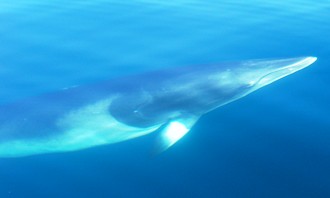 MINKE WHALES (year round) -
The common Minke Whale is black and grey on the dorsal (upper) side and white in the ventral (under) side. Some have a light colored chevron on their backs and a white band on each flipper. They have a very distinctive snout. It is triangular and smaller in proportion to other rorquals. They range in size from 25-35 feet and weigh up to 10 tons with the females being larger in order to care for their young. Their dorsal fins are located 2/3 of the way down the back and are tall and falcate (curved). The flukes are 1/4 of the body length and are notched in the center. Being so small, their spout may be hard to see and disappears quickly. They also exhale before surfacing which makes the blow smaller. The lifespan of a minke whale is 30-50 years.
MINKE WHALES (year round) -
The common Minke Whale is black and grey on the dorsal (upper) side and white in the ventral (under) side. Some have a light colored chevron on their backs and a white band on each flipper. They have a very distinctive snout. It is triangular and smaller in proportion to other rorquals. They range in size from 25-35 feet and weigh up to 10 tons with the females being larger in order to care for their young. Their dorsal fins are located 2/3 of the way down the back and are tall and falcate (curved). The flukes are 1/4 of the body length and are notched in the center. Being so small, their spout may be hard to see and disappears quickly. They also exhale before surfacing which makes the blow smaller. The lifespan of a minke whale is 30-50 years.
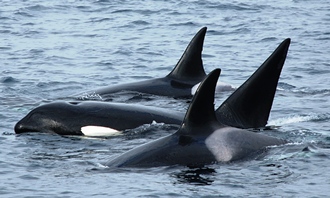 ORCA (KILLER WHALES) (Dec to Jan) -
The orca or killer whale is a toothed whale which is a misnomer because the killer whale is the largest member of the dolphin family. It is the largest predator in the mammal classification. When someone hears the word whale, a majority of people think of the orca because of its popularity in movies and theme parks. They are carnivores and extremely skillful in hunting their prey. The males can be up to 32 feet and weigh almost 9 tons. The females can be up to 25 feet and 4 tons. They are generally black and white but some can be black and cream colored. The dorsal (upper) side is black except for a patch behind the dorsal fin called the saddle. The ventral (under) side is white or cream colored as is a small patch around the eye. Killer whales are identified by their coloring and the shape of the dorsal fin. The males dorsal fin is like an isosceles triangle while the females or juvenile males have one that is falcate (curved).
ORCA (KILLER WHALES) (Dec to Jan) -
The orca or killer whale is a toothed whale which is a misnomer because the killer whale is the largest member of the dolphin family. It is the largest predator in the mammal classification. When someone hears the word whale, a majority of people think of the orca because of its popularity in movies and theme parks. They are carnivores and extremely skillful in hunting their prey. The males can be up to 32 feet and weigh almost 9 tons. The females can be up to 25 feet and 4 tons. They are generally black and white but some can be black and cream colored. The dorsal (upper) side is black except for a patch behind the dorsal fin called the saddle. The ventral (under) side is white or cream colored as is a small patch around the eye. Killer whales are identified by their coloring and the shape of the dorsal fin. The males dorsal fin is like an isosceles triangle while the females or juvenile males have one that is falcate (curved).
 COMMON DOLPHIN (year round) -
Common dolphins are very elaborate and have highly recognizable markings. The cape or area from its head to just beyond the dorsal fin is dark grey or brown and ends in a distinct "V" pattern. On its sides a yellowish-tan hourglass pattern can be seen with a white underside and lower sides. It has dark flippers, and a dark line from its flippers to its beak. They are so variable in their appearance that up to 20 species have been proposed but there is only one true species with 2 distinct forms, the long-beaked and short-beaked. The long beaked is more muted in color and has a more gradual melon and beak whereas the short-beaked is more robust, has a larger dorsal fin, and has a more dramatic melon that angles sharply into the beak. Common dolphins reach7.5-8.5 feet and can weigh nearly 300 lbs.
COMMON DOLPHIN (year round) -
Common dolphins are very elaborate and have highly recognizable markings. The cape or area from its head to just beyond the dorsal fin is dark grey or brown and ends in a distinct "V" pattern. On its sides a yellowish-tan hourglass pattern can be seen with a white underside and lower sides. It has dark flippers, and a dark line from its flippers to its beak. They are so variable in their appearance that up to 20 species have been proposed but there is only one true species with 2 distinct forms, the long-beaked and short-beaked. The long beaked is more muted in color and has a more gradual melon and beak whereas the short-beaked is more robust, has a larger dorsal fin, and has a more dramatic melon that angles sharply into the beak. Common dolphins reach7.5-8.5 feet and can weigh nearly 300 lbs.
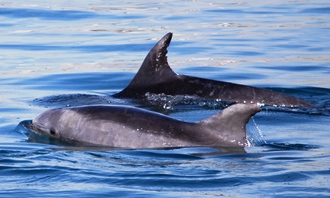 BOTTLE-NOSE DOLPHIN (year round) -
One of the most recognizable and often seen kinds of dolphins. Bottlenose dolphins have a short round beak hence the name "bottlenose" and are typically a grey color on top and pinkish white on their bellies. This is the most common used dolphin in marine parks and movies or TV shows such as "Flipper". This is mainly due to their size, intelligence, and more flexibility than other dolphin species. Bottlenose dolphins are much larger than you would think reaching a length of 8-12 feet and some being well over 1,000 lbs. The males are much larger than the females in this species. They are also identified by having a very high and curved dorsal fin.
BOTTLE-NOSE DOLPHIN (year round) -
One of the most recognizable and often seen kinds of dolphins. Bottlenose dolphins have a short round beak hence the name "bottlenose" and are typically a grey color on top and pinkish white on their bellies. This is the most common used dolphin in marine parks and movies or TV shows such as "Flipper". This is mainly due to their size, intelligence, and more flexibility than other dolphin species. Bottlenose dolphins are much larger than you would think reaching a length of 8-12 feet and some being well over 1,000 lbs. The males are much larger than the females in this species. They are also identified by having a very high and curved dorsal fin.
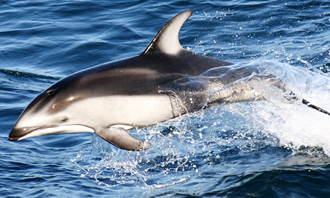 PACIFIC WHITE SIDED DOLPHIN (year round) -
The Pacific white-sided dolphin has a short, rounded, thick beak containing 23 to 32 small, rounded slightly curved teeth in each side of the upper and lower jaws. Its back is black and its sides are light gray with thin, white stripes that extend from above the eye along the sides, widening towards the tail; its belly is white. It has a black beak and lips and a black ring around each eye. Its dorsal fin is tall and sharply hooked, and is located at the center of the back. The leading edge is black and the rear portion is light gray. Its flippers are small and curved and rounded at the tips. Its flukes are notched in the center. These dolphins reach a length of 7 to 8 feet and weigh 300 pounds.
PACIFIC WHITE SIDED DOLPHIN (year round) -
The Pacific white-sided dolphin has a short, rounded, thick beak containing 23 to 32 small, rounded slightly curved teeth in each side of the upper and lower jaws. Its back is black and its sides are light gray with thin, white stripes that extend from above the eye along the sides, widening towards the tail; its belly is white. It has a black beak and lips and a black ring around each eye. Its dorsal fin is tall and sharply hooked, and is located at the center of the back. The leading edge is black and the rear portion is light gray. Its flippers are small and curved and rounded at the tips. Its flukes are notched in the center. These dolphins reach a length of 7 to 8 feet and weigh 300 pounds.

